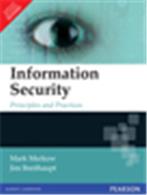Information Security: Principles and Practices

|
Author(s):
Author:
Mark Merkow
- ISBN:9788131712887
- 10 Digit ISBN:8131712885
-
Price:Rs. 1110.00
- Pages:275
- Imprint:Pearson Education
- Binding:Paperback
- Status:Available
-
|
For a introductory course in information security covering principles and practices.
This text has been developed to cover the 10 domains in the Information Security Common Body of Knowledge. They include: Security Management Practices, Security Architecture and Models, Business Continuity Planning (BCP) and Disaster Recovery Planning (DRP), Law, Investigations, and Ethics, Physical Security, Operations Security, Access Control Systems and Methodology, Cryptography, Telecommunications, Network, and Internet Security.
Table of Content
- Why Study Information Security?
- Information Security Principles of Success
- Certification Programs and the Common Body of Knowledge
- Security Management
- Security Architecture and Models
- Business Continuity Planning and Disaster Recovery Planning
- Law, Investigations, and Ethics
- Physical Security Control
- Operations Security
- Access Control Systems and Methodology
- Cryptography
- Telecommunications, Network, and Internet Security
- Application Development Security
- Securing the Future
- Appendix A: Common Body of Knowledge
- Appendix B: Security Policy and Standards Taxonomy
- Appendix C: Sample Policies
- Appendix D: HIPAA Security Rule Standards
- Glossary
- References
|
Salient Features
- Information Security Principles and Practices provides thorough coverage of each domain so students understand these widely accepted categories of information security.
- This text’s coverage of why students need to know about information security, principles of success and the future of information security prepares them for the real-world environment.
- Appendices include: Common Body of Knowledge, Security Policy and Standards Taxonomy, Sample Policies, and HIPAA Security Rule Standards, which provides students with real-life examples and additional resources.
|
|
|
|
|